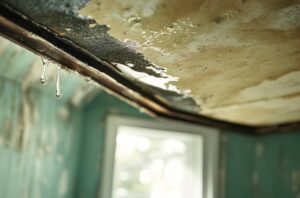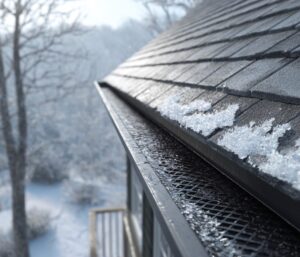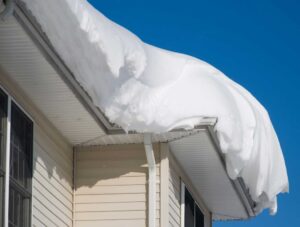You Deserve the Truth About Winter Roofing — Not Myths
We get it. It’s winter in Kansas City. You’ve spotted a leak, heard a drip, or noticed shingles out of place, and you’re wondering… “Can you even replace a roof in winter?”
Maybe you Googled it. Maybe you asked a neighbor. And now you’re caught in a web of conflicting advice—some of it outdated, some just flat-out wrong.
We’re Brewster Roofing, and we’ve been roofing in cold weather since 1964. We’ve replaced over 15,000 roofs—including plenty during snow, ice, and freezing temps. So we’re here to clear the air and squash the most common winter roofing myths Kansas City homeowners still hear every year.
If you’re putting off a roof inspection or delaying repairs because of something you heard about cold-weather roofing, this guide is for you.
What You’ll Learn in This Guide
- Why yes, you really can replace a roof in winter — and safely
- The six most common winter roofing myths (with real facts to debunk them)
- What makes Kansas City winters uniquely tough on roofs
- What cold-weather roofing requires for it to be safe and warranty-compliant
- How Brewster Roofing handles winter projects when other companies shut down
Why Winter Roofing in Kansas City Isn’t Optional
There’s a reason this topic matters—freeze-thaw cycles are brutal on roofs. Water gets into tiny cracks. Then it freezes. Then it expands. That movement pulls apart shingles, flashing, and even decking if you let it go long enough.
Kansas City gets 30 to 50 freeze-thaw cycles each winter. That’s dozens of opportunities for existing damage to get worse, not better.
The truth? Roofing in cold weather isn’t just possible—it’s sometimes the smartest move you can make. Let’s look at the six biggest myths we hear this time of year.
Myth #1: The Idea That Roof Repairs Can Be Safely Delayed Until Spring
The Truth: Waiting through winter could cost you more
Delaying a roof repair might feel like the “safe” option, but it often backfires. When temperatures drop, any trapped water expands, which turns a minor issue into major structural damage. It’s simple physics.
And here’s the kicker:
Most insurance policies require homeowners to act quickly. Waiting too long may jeopardize your coverage for what insurers call “secondary damage.”
Kansas City’s freeze-thaw cycles increase that risk. Every time the weather bounces from 20 degrees to 40 and back again, your roofing system is under stress. Letting that continue until spring means more damage—and more cost.
How Brewster Roofing can help:
We offer winter inspections, cold-weather repairs, and emergency tarping, even in freezing temps. Our teams are trained to work safely and seal properly at 25°F and above, following all manufacturer standards.
Myth #2: The Assumption That Winter Roof Damage Is Always Obvious
The Truth: Most damage stays hidden until it’s too late
It’s easy to think that “no visible damage” means “no problem.” But most of the winter roofing issues we find are hidden beneath the surface.
Here’s why:
- Ice dams trap water on your roof and force it underneath the shingles.
- Cracked flashing often looks fine from the ground.
- Moisture in your attic may be the first sign of a roof problem—but by then, it’s already inside.
Even missing shingles aren’t always obvious unless you’re up on the roof. And we don’t recommend climbing up there in December.
How Brewster Roofing can help:
We provide professional winter roof inspections that go deeper. We check your attic, flashing, shingle adhesion, and any signs of moisture intrusion—without risking your safety.
Myth #3: The Belief That a New Roof Doesn’t Need Winter Maintenance
The Truth: Even brand-new roofs need seasonal attention
We love new roofs. But we also know they’re not invincible.
During your roof’s first winter, there are a few things that still need checking:
- Seal strips may not activate fully in cold weather without sun exposure.
- Ventilation problems can still cause attic condensation.
- Gutter backups can happen even if your roof is brand new.
And here’s something most homeowners don’t realize: Even manufacturer warranties require some basic seasonal maintenance. Ignoring it can void your coverage.
How Brewster Roofing can help:
We offer winter maintenance services and can help you spot early issues—before they become expensive problems. Even if we didn’t install your roof, we can still help you protect it.

Myth #4: The Misconception That Roof Warranties Cover All Cold-Weather Damage
The Truth: Warranties come with conditions—and limits
We’ve read the fine print, so you don’t have to.
Most homeowners assume their roof warranty will cover any issue, anytime. But that’s not how it works. Warranties cover material defects, not storm damage, not DIY mistakes, and definitely not improper cold-weather installation.
Common warranty exclusions include:
- Ice dam damage
- Improper maintenance
- Poor attic ventilation
- Installation by non-certified contractors
How Brewster Roofing can help:
We’re a TAMKO Master Pro Dealer and a GAF Certified Contractor. That means your new roof is installed to spec—even in cold weather—and your warranty stays intact. We also offer a 5-year workmanship warranty on every install.
Myth #5: The Common Thinking That DIY Roof Repairs Are Fine in Winter
The Truth: DIY roofing in winter is risky—and often voids your warranty
We love a good DIY project—but winter roofing isn’t one of them.
Why?
- Shingles crack more easily in cold temps.
- Sealants behave differently, requiring manual sealing and extra fasteners.
- And let’s be honest—icy slopes are dangerous.
More importantly, if you damage your shingles, you may invalidate your product warranty.
How Brewster Roofing can help:
Our crews are trained and certified in cold-weather techniques. We follow OSHA safety standards, use manufacturer-approved adhesives, and don’t cut corners. We do it once, and we do it right.
Myth #6: The Claim That Metal Roofing Isn’t Built for Snow and Ice Conditions
The Truth: Metal roofs are actually excellent in winter conditions
This one surprises a lot of homeowners. Some people worry that snow will slide off too quickly, or that the panels can’t handle freeze-thaw cycles. In fact, the opposite is true.
When installed correctly, metal roofing is one of the most winter-friendly materials out there.
Stone-coated steel and standing seam roofs:
- Shed snow naturally (reducing stress on your structure)
- Resist cracking and moisture intrusion
- Work great with snow guards and heat cables, when needed
How Brewster Roofing can help:
We install Decra stone-coated steel, snap-lock standing seam, and other cold-weather metal systems. We also fabricate custom snow retention and flashing solutions to fit your home and local climate.
Answers to Common Winter Roofing Questions from Kansas City Homeowners
We talk to hundreds of homeowners every year who have similar questions about roofing in cold weather. To wrap up this guide, we’ve gathered some of the most common concerns—and answered them clearly. Whether you’re wondering about timelines, warranties, or materials, these Q&As are here to help.
Can you really replace a roof in winter?
Yes, you can replace a roof in winter as long as temperatures are above 25°F and the installation follows cold-weather manufacturer guidelines. At Brewster Roofing, we use certified techniques that make winter roof replacements safe, effective, and fully compliant with warranty requirements.
Will my roof warranty still be valid if the installation happens in cold weather?
Your roof warranty will still be valid if the installation happens in cold weather, provided that certified cold-weather procedures are followed. This includes manual sealing and proper fastener use, which Brewster Roofing uses on all winter projects to ensure full warranty coverage.
Is roofing in winter more expensive than roofing in warmer months?
Roofing in winter is not usually more expensive than roofing in warmer months. In many cases, pricing remains consistent year-round, and scheduling availability may even be better during colder seasons due to lower demand.
Is metal roofing a smart choice for snowy or icy Kansas City winters?
Metal roofing is a smart and durable choice for snowy or icy Kansas City winters. With proper installation, snow guards, and ventilation, metal roofs shed snow efficiently, resist freeze-thaw damage, and offer long-term performance in cold climates.
Should I schedule a winter roof inspection even if I don’t see visible damage?
You should schedule a winter roof inspection even if you don’t see visible damage. Many winter roofing issues—like attic condensation, ice dams, and slow leaks—develop out of sight and worsen over time. An inspection now can catch those problems early and help you avoid major repairs later.
Final Thoughts: Don’t Let Winter Myths Put Your Roof at Risk
When it comes to winter roofing myths, bad advice can be costly. And in Kansas City, winter isn’t just inconvenient—it’s hard on your roof.
But here’s the good news:
Yes, you can repair or replace a roof in winter.
Yes, roofing in cold weather can be done right.
No, you don’t have to wait and hope for the best.
At Brewster Roofing, we’ve done this for 60 years. We work year-round. We follow the guidelines that keep your home protected and your warranties valid.
Don’t wait until spring. Schedule your winter inspection or repair today. Contact Brewster Roofing.
We’ll give you straight answers, no pressure, and a roof that’s ready for anything Kansas City throws at it.






